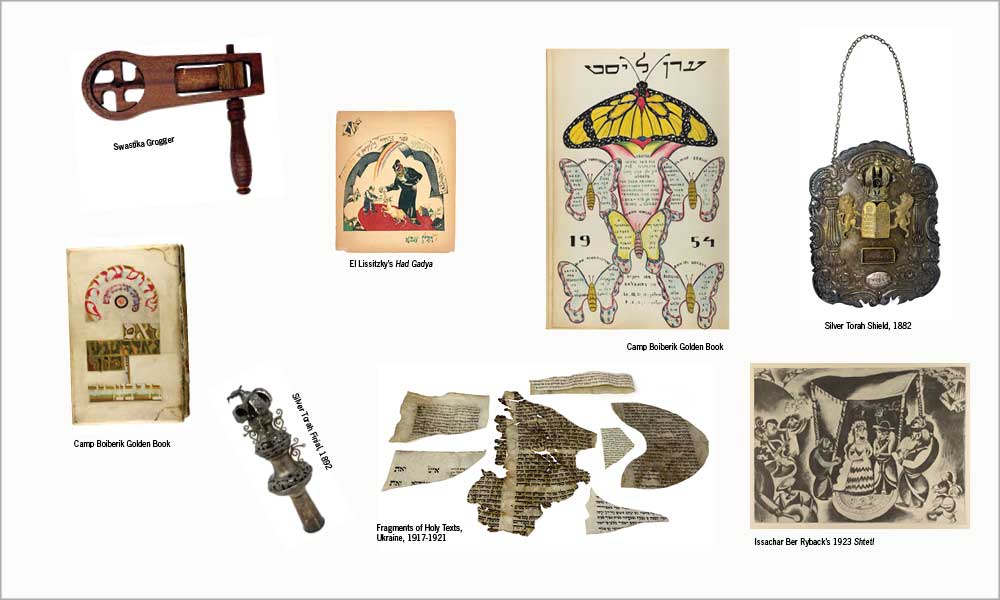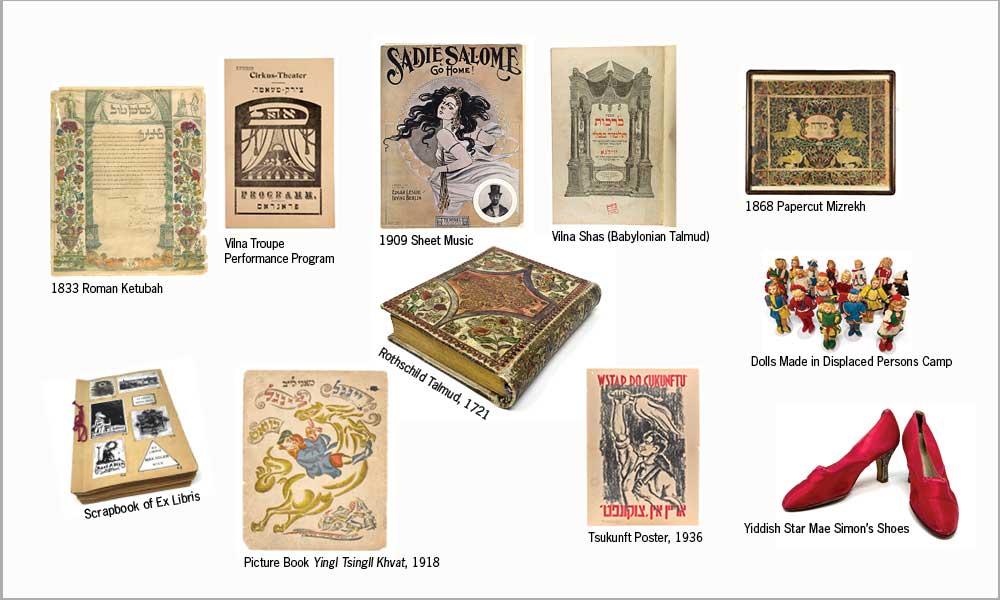
Theodor Herzl’s 1882-1889 Vienna diary. A circa 1945 German or Austrian grogger bearing the image of a swastika. Fragments of holy texts from early 20th-century Ukraine. A 1943 ledger of “Arrivals and Departures” for Auschwitz Block 8. A 1906 photograph of Jewish gauchos in Argentina. An immigration quota cartoon from 1924. A copy of the United States Constitution and Declaration of Independence in Yiddish and English. A glass bong from Texas in the shape of a menorah.
An evocative and sprawling array, to say the least. A number of these items can be seen in three special 100th anniversary exhibitions currently on view at the YIVO Institute for Jewish Research in New York City. Running through December 31, the exhibitions highlight the breadth and depth of YIVO’s collections—the single largest resource for the study of East European Jewish life and the most complete collection of Yiddish language books, pamphlets and newspapers in the world.
The YIVO Institute of Jewish Research was founded in 1925 in Vilna, Poland (now Vilnius, Lithuania), by a group of secular scholars and intellectuals intent on documenting, studying and preserving Jewish life in all its varied aspects—language, history, religion, folklore, customs and material culture. The Institute functioned as a national Jewish library, a university and an academy, becoming the preeminent authority on Yiddish culture and Jewish scholarship and playing a crucial role in standardizing the Yiddish language. Albert Einstein and Sigmund Freud were on YIVO’s first honorary board, but the organization was also dedicated to common citizens and daily life. Amateur zamlers (Yiddish for collectors) devoted themselves to gathering the ephemera of everyday life from Jews throughout Europe.
Based in Vilna, the Institute had satellite offices in Berlin, Warsaw and New York City. Managing to survive a harsh Soviet occupation at the onset of WWII; a brutal Nazi occupation; the murder of most of its staff; and the looting, dispersal and destruction of its collections, this treasure-house of Jewish learning and life re-established itself in 1940 at its branch in New York City. The Institute now comprises 24 million unique documents and artifacts in multiple languages, including the largest collection of primary-source Holocaust materials in North America. Its library has grown to more than 400,000 volumes, including tens of thousands of periodicals and 2,000 rare volumes going back to the 16th century.

Photo credit: Courtesy of the YIVO Institute for Jewish Research
The current exhibitions carry visitors back to a lost world through displays of the art, artifacts and accoutrements that formed the essence of Eastern European Jewish life. “Hail to the Zamlers: YIVO’s Collections at 100” pays tribute to the generations of volunteers, scholars and everyday Jews who toiled to collect and preserve the 1,000-year-old culture of Ashkenazi Jewry. Visitors to the exhibit can come face to face with the 1925 image of an aged tavern keeper and her husband from Suchestaw, Galicia; examine a 1941 children’s album from the Lodz ghetto; and be engaged by artist El Lissitzky’s 1919 illustrated Had Gadya. An array of posters and pamphlets advertise everything from the importance of breastfeeding to lively film and theater productions. The exhibit features more than 70 such artifacts displayed in six sections: performing and visual arts, immigration, the Jewish labor movement, the evolution of Yiddish literature and the story of YIVO itself.
“The Paper Brigade: Smuggling Jewish Treasures in Nazi-Occupied Vilna” tells the story of a bold group of Jewish poets and scholars who during the Holocaust risked everything to preserve their cultural heritage. Conscripted by the Nazis to sort and pack rare Jewish cultural treasures for shipment to Germany for the Nazi Institute for the Investigation of the Jewish Question (so the Nazis could document the culture they were determined to destroy), these men and women smuggled rare books and manuscripts from the YIVO building to the Vilna ghetto, where they hid and buried them in the hope they would survive the war. “Ghetto inmates looked at us as if we were lunatics,” wrote one of these heroes, poet Shmerke Kaczerginski. “They were smuggling foodstuffs into the ghetto, in their clothes and boots. We were smuggling books, pieces of paper, occasionally a Torah scroll or mezuzahs.” Much of what was rescued was eventually sent to New York.
The third exhibition, “The Strashun Library: Rare Books Rescued from the Ashes in Vilna,” showcases the Institute’s library. Founded in 1892, the Strashun was the first Jewish public library in the world, open to scholars, students and ordinary readers alike. Built on the prestigious collection of renowned scholar Rabbi Matisyahu Strashun, the library expanded in Vilna to include more than 35,000 volumes until it was looted by the Nazis during World War II. Some of the books were hidden in the ghetto, others were smuggled out. A significant portion of the original volumes are housed at YIVO, which is located at the Center of Jewish History in Lower Manhattan.
In addition to the three exhibitions, YIVO has put out an impressive publication—100 Objects from the Collections of the YIVO Institute for Jewish Research—many of which are on display in the current exhibitions.
“For 100 years, YIVO has preserved the legacy of one thousand years of Ashkenazi Jewish life,” says YIVO Executive Director and CEO Jonathan Brent. “Today its collections, programming and educational initiatives tell the story of what we have cherished, what we have endured, and how we have persisted. It is the story from which the future of the Jewish people will be built.”
